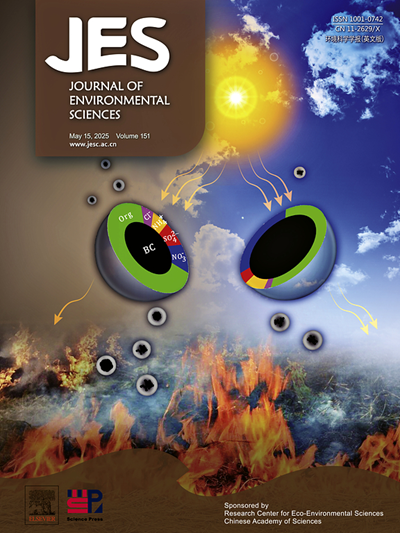Effect of sterically hindered amines on the cycling capacity of biphasic absorbents for industrial CO2 capture
IF 5.9
2区 环境科学与生态学
Q1 ENVIRONMENTAL SCIENCES
引用次数: 0
Abstract
The biphasic solvent is a promising solution to reduce regeneration energy consumption in CO2 capture. However, most current biphasic solvents suffer from high viscosity and poor desorption of the rich phase. To the issues, a novel pentamethyldiethylenetriamine (PMDETA)-2-amino-2-methyl-1-propanol (AMP)/diethylenetriamine (DETA)-sulfolane biphasic solvent was developed. The mechanism of AMP affecting CO2 recycling capacity was analyzed. By adjusting the ratio of AMP and DETA, the absorption and desorption performance were balanced, and the recycling capacity and renewable energy consumption of the absorbent were improved. For the P2.4A0.8D0.8S2 biphasic solvent, the CO2 loading of the rich phase was 5.87 mol/L, and the proportion of the rich phase volume ratio was 35%, which surpasses most reported biphasic solvents. The viscosity of the absorbent significantly decreased from 527.00 mPa·s to 92.26 mPa·s, attributed to the beneficial effect of AMP. Thermodynamic analysis showed that the biphasic solvent produced a lower regeneration energy consumption of 1.70 GJ/t CO2, which was 57% lower than that of monoethanolamine (MEA). Overall, the PMDETA-AMP/DETA-sulfolane biphasic solvent exhibited cycle capacity, which provided new insights for the designing of biphasic solvent.
位阻胺对工业CO2捕集双相吸收剂循环能力的影响
双相溶剂是一种很有前途的解决方案,可以减少二氧化碳捕获中再生能源的消耗。然而,目前大多数双相溶剂存在高粘度和富相解吸性差的问题。针对这些问题,研制了新型五甲基二乙基三胺(PMDETA)-2-氨基-2-甲基-1-丙醇(AMP)/二乙基三胺(DETA)-亚砜双相溶剂。分析了AMP影响CO2循环能力的机理。通过调整AMP和DETA的比例,平衡了吸附剂的吸附和解吸性能,提高了吸附剂的回收能力和可再生能源消耗。对于P2.4A0.8D0.8S2双相溶剂,富相的CO2负荷为5.87 mol/L,富相体积比占比为35%,超过了目前报道的大多数双相溶剂。由于AMP的有利作用,吸收剂的粘度从527.00 mPa·s显著降低到92.26 mPa·s。热力学分析表明,双相溶剂产生的再生能耗为1.70 GJ/t CO2,比单乙醇胺(MEA)低57%。总体而言,PMDETA-AMP/ deta -亚砜双相溶剂具有良好的循环能力,为双相溶剂的设计提供了新的思路。
本文章由计算机程序翻译,如有差异,请以英文原文为准。
求助全文
约1分钟内获得全文
求助全文
来源期刊

Journal of Environmental Sciences-china
环境科学-环境科学
CiteScore
13.70
自引率
0.00%
发文量
6354
审稿时长
2.6 months
期刊介绍:
The Journal of Environmental Sciences is an international journal started in 1989. The journal is devoted to publish original, peer-reviewed research papers on main aspects of environmental sciences, such as environmental chemistry, environmental biology, ecology, geosciences and environmental physics. Appropriate subjects include basic and applied research on atmospheric, terrestrial and aquatic environments, pollution control and abatement technology, conservation of natural resources, environmental health and toxicology. Announcements of international environmental science meetings and other recent information are also included.
 求助内容:
求助内容: 应助结果提醒方式:
应助结果提醒方式:


